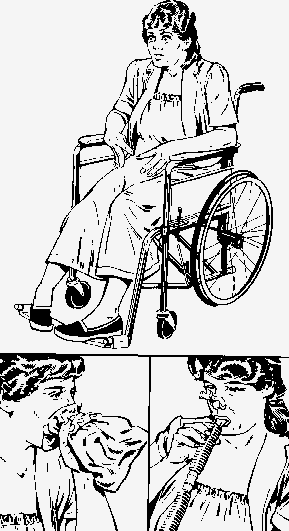1.02 Hyperventilation
agk’s Library of Common Simple Emergencies
Presentation
The patient is anxious and complains of shortness of breath and an inability to fill the lungs adequately. A patient may also have palpitations, chest or abdominal pain, and tingling or numbness around the mouth and fingers, or possibly even flexor spasm of the hands and feet. His respiratory volume is increased, which may be apparent by an increased respiratory rate, or only be an increased tidal volume or frequent sighing. The remainder of the physical examination is normal. The patient’s history may reveal an obvious precipitating emotional cause (such as having been caught stealing or being in the midst of a family quarrel).
What to do:
- Perform a brief physical examination, checking especially that the patient’s mental status is good, there is no unusual breath odor, there are good, equal excursion and breath sounds in both sides of the chest, and there is no swelling, pain or inflammation of the legs.
- Measure pulse oximetry, which should be 98-100%.
- Explain to the patient the cycle in which rapid, deep breathing can cause physical symptoms upsetting enough to cause further rapid, deep breathing. Repeat a cadence (“in…out…in…”) to help him voluntarily slow his breathing, or have him voluntarily hold his breath for a while.
- If he cannot reduce his ventilatory rate and volume, provide a paper bag or length of tubing through which to breathe, keeping the pulse oximetry monitor on to avoid hypoxia. This will allow him to continue moving a large quantity of air, but provide air rich in carbon dioxide, allowing the blood Pco2 to rise towards normal. (Carbogen gas (5% CO2) may also be used, if available.) Administration of 50-100mg of hydroxyzine (Vistaril) im often helps to calm the patient.
- If you cannot reverse these symptoms and reduce respiratory effect in this manner in 15-20 minutes, you should double check the diagnosis by obtaining arterial blood gases, looking for a metabolic acidosis or hypoxia indicative of underlying disease.
- Reexamine the patient after hyperventilation is controlled.
- Make sure the patient understands the hyperventilation syndrome and knows some strategies for breaking the cycle next time. (It may be valuable to have him reproduce the symptoms voluntarily.) Arrange for followup as needed.
What not to do:
- Do not miss the true medical emergencies which also present as hyperventilation, including: pneumothorax, pneumonia, pulmonary embolus, diabetic ketoacidosis, salicylate overdose, sepsis, uremia, myocardial infarction and CVA.
- Do not use a paper bag on a patient with a low oxygen saturation on pulse oximetry (<96%)
Discussion
The acute metabolic alkalosis of hyperventilation causes transient imbalances of calcium, potassium, and perhaps other ions, with the net effect of increasing the irritability and spontaneous depolarization of excitable muscles and nerves. First-time victims of the hyperventilation syndrome are the most apt to visit the ED, and this is an excellent time to educate them about its pathophysiology and the prevention of recurrence. Repeat visitors may be overly excitable or may have emotional problems and need counseling.
References:
- Demeter SL, Cordasco EM: Hyperventilation syndrome and asthma. Am J Med 1986;81:989-994.
- Callaham M: Hypoxic hazards of traditional paper bag rebreathing in hyperventilating patients. Ann Emerg Med 1989;18:622-628.
Illustration

-----------------------------------------------------
from Buttaravoli & Stair: COMMON SIMPLE EMERGENCIES ©
Longwood Information LLC 4822 Quebec St NW Washington DC 20016-3229
1.202.237.0971 fax 1.202.244.8393 electra@clark.net
-----------------------------------------------------

